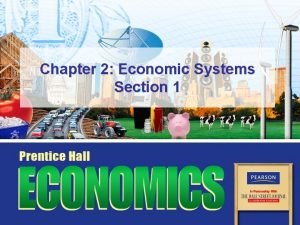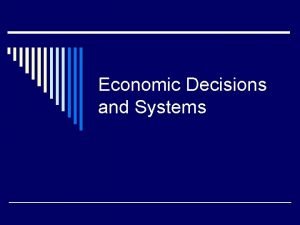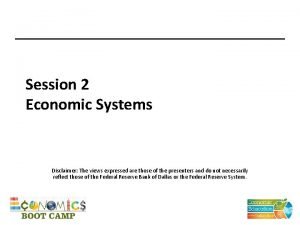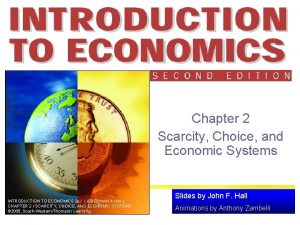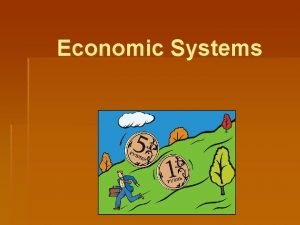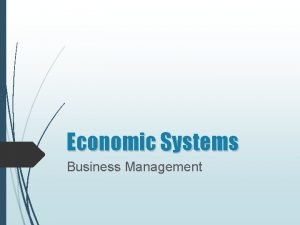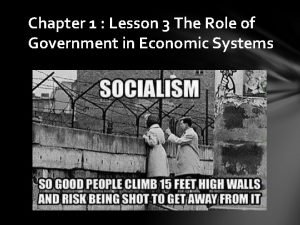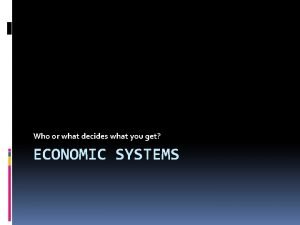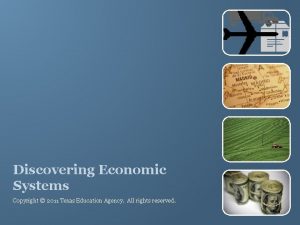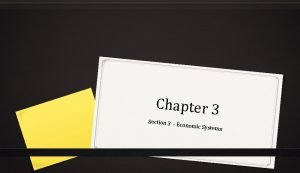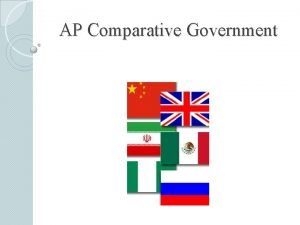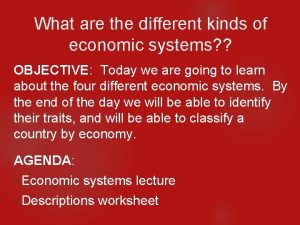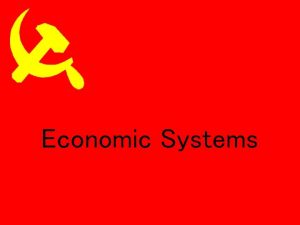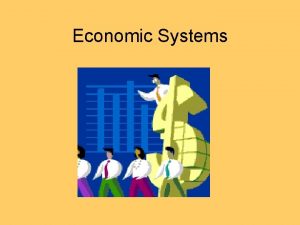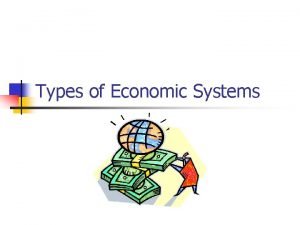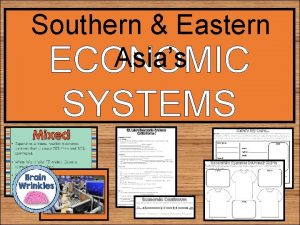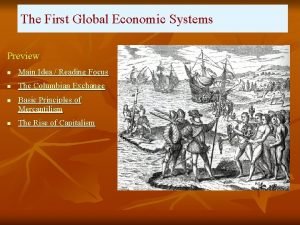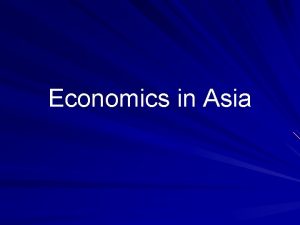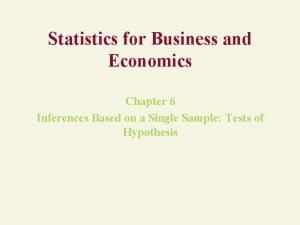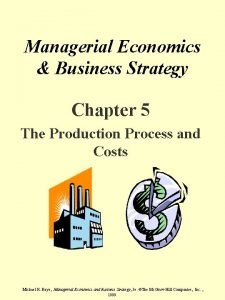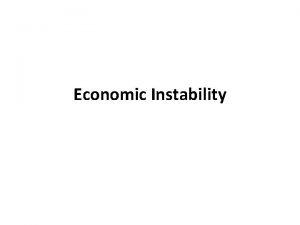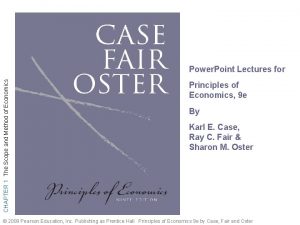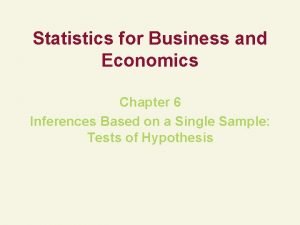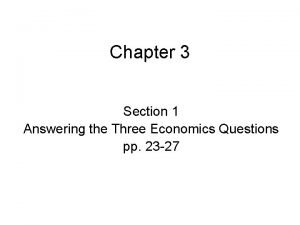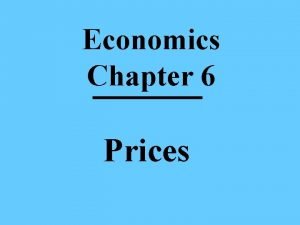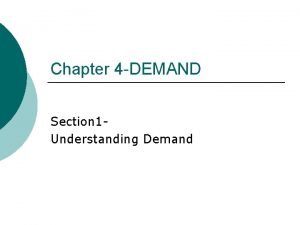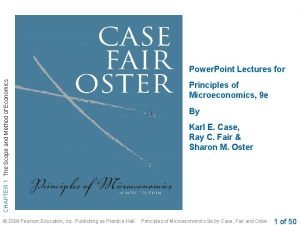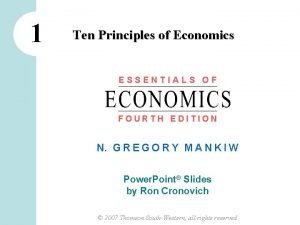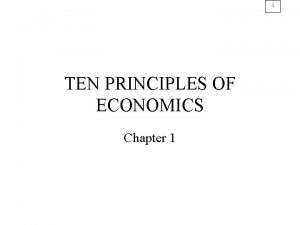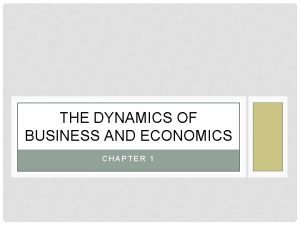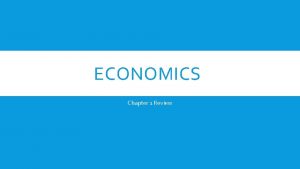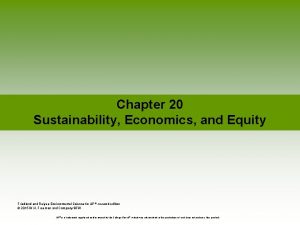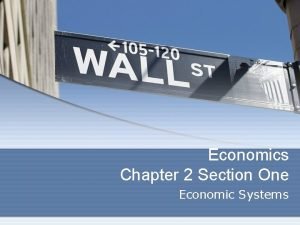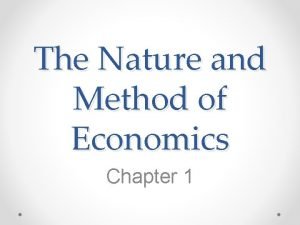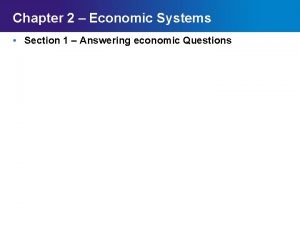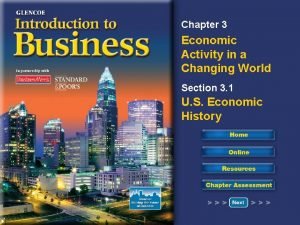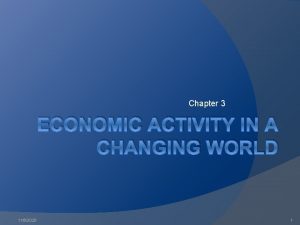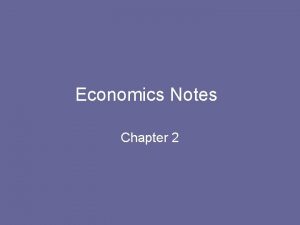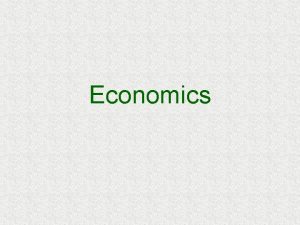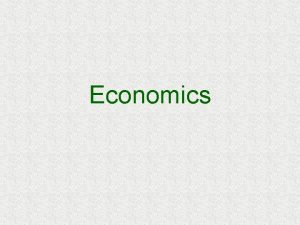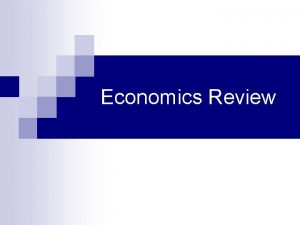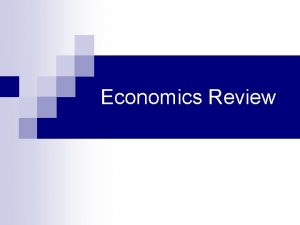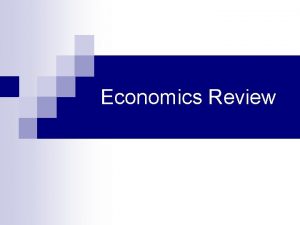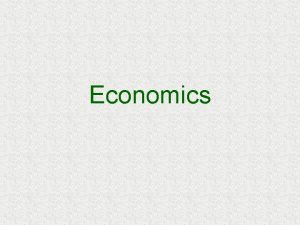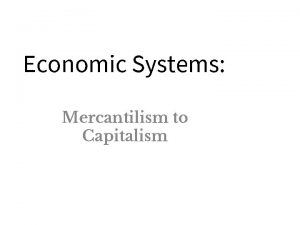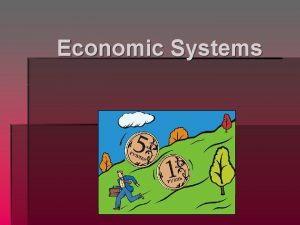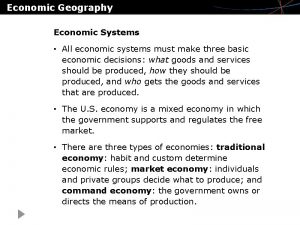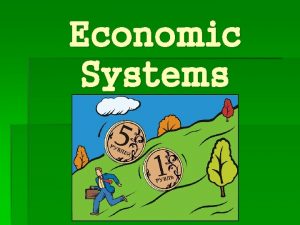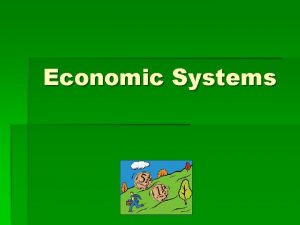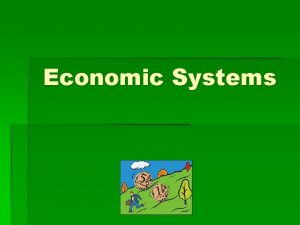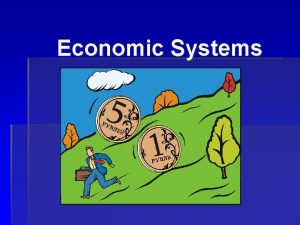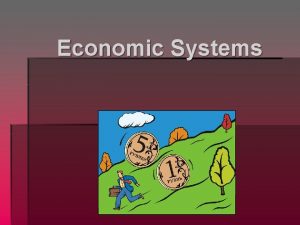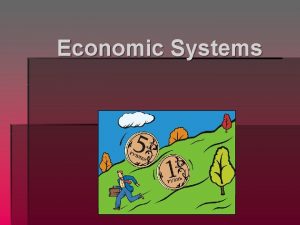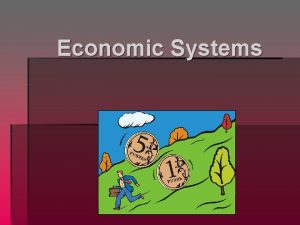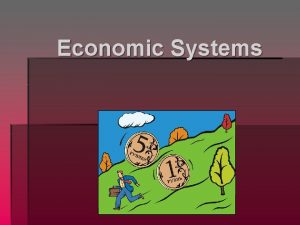Economics Chapter 2 Economic Systems Chapter 2 Economic
































































- Slides: 64

Economics Chapter 2 Economic Systems

Chapter 2: Economic Decisions 2. 1 Economic Systems 2. 2 Evaluating Economic Performance 2. 3 Capitalism and Economic Freedom

2. 1 Economic Systems ACOS: 2. Compare the development and characteristics of the world’s traditional, command, and market economies.

2. 1 Economic Systems Daily Objectives: �Describe the characteristics of the traditional, command, and market economies. �Explain the advantages and disadvantages of the traditional, command, and market economies.

2. 1 Economic Systems �Traditional Economies �Command Economies �Market Economies �Three Requirements for a Market Economy

Economic Systems �An economy is “organized way of providing for wants and needs of their people. ” �Most countries have a traditional, command, or market economy. Joseph Stalin

Traditional Economies �The distribution of scarce resources is determined by ritual, habit, or custom. �Many indigenous peoples like the Australian Aborigines utilize the traditional economy.

Traditional Economies �The biggest advantage is that each person knows what roles to play. �The problem is that it discourages creativity and new ways of doing things. �This results in a lower standard of living.

Command Economies �A central authority answers the three basic questions in a command economy. �Examples include Cuba, North Korea, and the former Soviet Union. �The strength of this system is that it can adjust to needs quickly.

Command Economies �Command economies have several disadvantages: ◦ It does little to address the wants of consumers. ◦ It does not give people incentive to work hard. �Most workers receive similar pay. (Ex: doctors and janitors) �Workers are often assigned jobs below their potential.

Command Economies ◦ A large bureaucracy is necessary to make decisions. �This results in inefficiency. �This increases production costs. ◦ It does not have flexibility to adjust to little issues. ◦ Creativity is limited, and little incentive is offered to workers.

Market Economies �People and firms answer the three basic questions. �People “vote” for what they want with their money. �Examples include the U. S. , Canada, Japan, South Korea, Britain, and other Western European nations.

Market Economies �The ability to adjust to change over time is a strength of this system. (ex: gas shortages in 1970 s) ◦ Change is not discouraged like the traditional economy. ◦ Change is not delayed or forced on people as in a command economy.



Market Economies �Another strength of the market economy is its emphasis on individual freedom. �Government influence is kept to a minimum. �Another strength of the market economy is the fact that decision making is made by the people themselves.

Market Economies �This results in a variety of goods and services. �Customer satisfaction is much greater in a market economy.

Market Economies �The market economy has some disadvantages as well. ◦ It does not provide for the basic needs of everyone in society. ◦ It is unable to provide some services efficiently. (ex: national defense) ◦ Uncertainty about the future may also be a weakness. (ex: unemployment)

National Defense

Unemployme nt


Three Requirements for a Market Economy �Competition is necessary. �Resources must be free to change to other activities. (ex: worker changing job) �Consumers need sufficient information to make wise economic decisions.

2. 2 EVALUATING ECONOMIC PERFORMANCE

ACOS: 2. COMPARE THE DEVELOPMENT AND CHARACTERISTICS OF THE WORLD’S TRADITIONAL, COMMAND, AND MARKET ECONOMIES.

Objectives: �Describe the basic economic and social goals used to evaluate economic performance. �Evaluate the trade-offs among economic and social goals.

2. 2 Evaluating Economic Performance �Seven Economic and Social �Economic Freedom �Economic Efficiency �Economic Equity �Economic Security �Full Employment �Price Stability �Economic Growth �Other Goals and Choices �Internet Resources Goals

Seven Economic and Social Goals �Economic Freedom �Economic Efficiency �Economic Equity �Economic Security �Full employment �Price stability �Economic Growth

Economic Freedom �This goal promotes an individual’s ability to choose careers and how to spend money. �It also allows businesses to choose where and how to produce their goods and services.

Economic Efficiency �This goal seeks to be resourceful with scarce factors of production. �It also reflects the desire that benefits outweigh the costs of production.

Economic Equity �This social goal seeks fairness among workers. �Minimum wage laws reflect this goal.


Economic Security �This social goal seeks to provide for the unhealthy, elderly, and unhealthy. �Social Security is a federal program that provides disability and retirement benefits for working people.



Full Employment �This goal states that those with the necessary skills and are willing to work have jobs. �This does not mean all adults have jobs.

Price Stability �This goal seeks a consistent level in prices of goods and services. �Inflation is a rise in the general level of prices.


Price Stability �People with a fixed income have difficulty dealing with inflation. �Interests rates usually rise with inflation. �This makes it harder for businesses to borrow and spend money.

Economic Growth �Growth allows people to enjoy more goods and services. �Economic growth is necessary for nations with growing populations.

Other Goals and Choices �Societies may gain new goals. (ex: clean environments) �Societies may face trade-offs to achieve certain goals. �They must

Internet Resources �http: //www. bls. gov/oco/

2. 3 CAPITALISM AND ECONOMIC FREEDOM

ACOS: 2. COMPARE THE DEVELOPMENT AND CHARACTERISTICS OF THE WORLD’S TRADITIONAL, COMMAND, AND MARKET ECONOMIES.

2. 3 Capitalism and Economic Freedom Objectives: �Explore the characteristics of a free enterprise system. �Describe the role of the entrepreneur, the consumer, and government in a free enterprise economy.

2. 3 Capitalism and Economic Freedom �Capitalism �Five Characteristics of a Free Enterprise Economy �Economic Freedom �Voluntary Exchange �Private Property Rights �Profit Motive �Competition � The Role of the Entrepreneur � The Role of the Consumer � The Role of Government

Capitalism �Capitalism is “a system in which private citizens own the factors of production. ” �The American economy is a free enterprise system. �The phrase free enterprise refers to an “economy in which competition is allowed to flourish with a minimum of government interference.

Five Characteristics of a Free Enterprise Economy 1. 2. 3. 4. 5. Economic Freedom Voluntary Exchange Private Property Rights Profit Motive Competition

Economic Freedom �People choose where they want to work. �Businesses can charge what they want. �Both are free to risk success or failure.

Voluntary Exchange �Voluntary exchange is the act of buyers and sellers freely and willingly engaging in market transaction. �Buyers and sellers both benefit from the sales.

Private Property Rights �Private property refers to tangible and intangible items. �It gives people the incentive to work and improve their standard of living. �People take better care of their own property.

Profit Motive �People become entrepreneurs hoping to make a profit. �Entrepreneurs take risks hoping to make money. �The profit motive is the “driving force that encourages people and organizations to improve their material well-being. ” Steve Jobs and the IPad 2

Competition �Competition is “the struggle among sellers to attract consumers while lowering costs. ” �It results in the production of goods and services at the lowest cost and distribution to consumers who are able and willing to pay.

The Role of the Entrepreneur �Entrepreneurs start new businesses. �Many business attempts fail. �Very few become overwhelmingly successful as Bill Gates or Walt Disney. �Despite high risks, people still seek success.

The Role of the Entrepreneur �Everyone benefits when an entrepreneur is successful. �Other firms are attracted to the industry created by successful entrepreneurs. �This results in: ◦ ◦ ◦ New products, Greater competition, more production higher quality lower prices for consumers.

The Role of the Consumer �Consumers are sovereign in the free market economy because they determine the success of a good or service. �IPods, Kindles, and cell phones are successful because buyers want them.

The Role of the Consumer �Celery-flavored Jell -O, chewable toothpaste tablets, and toaster-ready bacon have all failed because the public did not purchase them. �Consumers “vote” for what by how they spend their money.


The Role of Government �Government plays five roles in the economy. �As a protector, government passes and enforces laws to prevent consumers and workers from being abused. (Ex: lemon laws, FDA) �As a provider, government supplies goods and services like national defense and education.

The Role of Government �As a consumer, government uses factors of production in order to provide. �Government has become the second largest consuming unit in the economy, second only to the consumer sector.

The Role of Government �As a regulator, government works to ensure fair competition. �As a promoter of national goals, government influences the economy to achieve the seven basic economic and social goals. �The U. S. has a mixed economy (modified private enterprise economy) where some government control is present.

TEST TOMORROW!

CHAPTER 2 REVIEW QUESTIONS

Chapter 2 Review Questions 1. 2. 3. 4. 5. 6. Describe a traditional economy. Describe a command economy. Describe a market economy. Describe the advantages and disadvantages of a traditional economy. Describe the advantages and disadvantages of a command economy. Describe the advantages and

Chapter 2 Review Questions Describe the basic economic and social goals used to evaluate economic performance. 8. Evaluate the trade-offs among economic and social goals. 9. Briefly describe the five characteristics of a free enterprise system. 10. Describe the role of the entrepreneur in a free enterprise system. 11. Describe the role of the consumer in a free enterprise system. 12. Describe the role of government in a free enterprise system. 7.
 Economics unit 1 lesson 2 difficult choices
Economics unit 1 lesson 2 difficult choices Maastricht university school of business and economics
Maastricht university school of business and economics Mathematical economics vs non mathematical economics
Mathematical economics vs non mathematical economics Chapter 2 economic systems and decision making answer key
Chapter 2 economic systems and decision making answer key Chapter 2 economic systems answer key
Chapter 2 economic systems answer key Chapter 2 economic systems and decision making
Chapter 2 economic systems and decision making Chapter 2 economic systems and decision making
Chapter 2 economic systems and decision making Chapter 1 economic decisions and systems answer key
Chapter 1 economic decisions and systems answer key Comparing economic systems worksheet
Comparing economic systems worksheet Fundamental concept
Fundamental concept Economics systems
Economics systems Economics systems
Economics systems Economic growth vs economic development
Economic growth vs economic development Conclusion of growth and development
Conclusion of growth and development Education health and famine comprehension check
Education health and famine comprehension check Economic systems examples
Economic systems examples Economic system example
Economic system example How many economic systems are there
How many economic systems are there Command economy political cartoon
Command economy political cartoon Lesson 3 the role of government in economic systems
Lesson 3 the role of government in economic systems Africa's economic systems cloze notes 2
Africa's economic systems cloze notes 2 Economic systems
Economic systems Free enterprise system def
Free enterprise system def Discovering economic systems guided practice
Discovering economic systems guided practice The three economic systems
The three economic systems Economic systems
Economic systems Africa's economic systems cloze notes 1
Africa's economic systems cloze notes 1 Traditional economy
Traditional economy Why do we have economic systems
Why do we have economic systems Disadvantages of a planned economy
Disadvantages of a planned economy Types of economic systems
Types of economic systems Economic systems chart
Economic systems chart Market economy
Market economy The first global economic systems
The first global economic systems What do economic systems seek to do?
What do economic systems seek to do? Decision support systems and intelligent systems
Decision support systems and intelligent systems Engineering elegant systems: theory of systems engineering
Engineering elegant systems: theory of systems engineering Embedded systems vs cyber physical systems
Embedded systems vs cyber physical systems Engineering elegant systems: theory of systems engineering
Engineering elegant systems: theory of systems engineering One proportion z test
One proportion z test Ecomics
Ecomics Lesson quiz 13-1 economic instability
Lesson quiz 13-1 economic instability Chapter 28 unemployment
Chapter 28 unemployment The scope and method of economics chapter 1
The scope and method of economics chapter 1 When to use z test and t test
When to use z test and t test Economics chapter 3 section 1 answer key
Economics chapter 3 section 1 answer key Ten principles of economics chapter 1
Ten principles of economics chapter 1 Chapter 1 the dynamics of business and economics
Chapter 1 the dynamics of business and economics Chapter 2 economics and environmental policy
Chapter 2 economics and environmental policy Chapter 6 section 1 economics
Chapter 6 section 1 economics Economics chapter 4 section 1 understanding demand answers
Economics chapter 4 section 1 understanding demand answers The scope and method of economics chapter 1
The scope and method of economics chapter 1 One of the ten principles of economics in chapter 1
One of the ten principles of economics in chapter 1 Ten principles of economics chapter 1
Ten principles of economics chapter 1 Chapter 1 the dynamics of business and economics
Chapter 1 the dynamics of business and economics Economics chapter 1 review
Economics chapter 1 review Apes chapter 20 sustainability economics and equity
Apes chapter 20 sustainability economics and equity Economics chapter 2 section 3
Economics chapter 2 section 3 The scope and method of economics chapter 1
The scope and method of economics chapter 1 Managerial economics chapter 1
Managerial economics chapter 1 Chapter 4 lesson 1 what is demand
Chapter 4 lesson 1 what is demand Economics chapter 4 demand
Economics chapter 4 demand Economics chapter 2 section 3 assessment answers
Economics chapter 2 section 3 assessment answers Chapter 3 economic activity in a changing world
Chapter 3 economic activity in a changing world Chapter 3 economic activity in a changing world
Chapter 3 economic activity in a changing world




